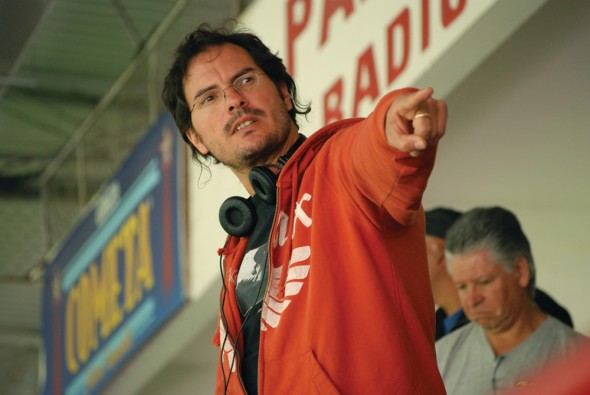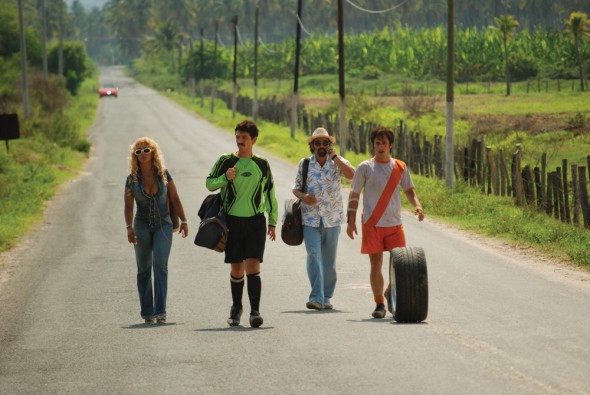Carlos Cuarón unravels universal themes in the language of cinema’s new era.
A fraternity of Mexican filmmakers is credited with ushering in a new cinematic movida, an epoch during which prescribed storytelling maxims have been dismantled and the visibility of Latin American films has swelled internationally. These men, of course, are Alfonso Cuarón, Guillermo del Toro and Alejandro González Iñárritu, a talented triptych unofficially anointed as Mexico’s contemporary silver screen pioneers.
While the compatriots have recently enjoyed artistic commendation, a silent partner who has played a crucial role in said zeitgeist is just now emerging from behind the scenes. This man is Carlos Cuarón, brother of Alfonso, and best known as the scribe of 2001’s sexed-up road trip movie Y Tu Mamá También. Cuarón’s feature directorial debut Rudo y Cursi is eliciting an excited buzz, primarily because it marks the major reunion of Gael García Bernal and Diego Luna on screen.
Bernal and Luna play “Rudo” (“tough”) and “Cursi” (“corny”), a pair of football playing brothers, whose ascent from banana plantation workers to sports stars tests their fraternal bonds and inflates their respective vanities. Assume that the consequences are not wholly pleasant.
Sitting by Cuarón’s side as we discussed the film in the plush climes of la’s Chateau Marmont, it was obvious he had landed squarely in Hollywood, with a promising reception as an auteur. He offers soma his thoughts on writing, collaborating with his artistic brethren and the evolution of Mexican cinema.

What was the genesis of the project for you?
I wanted to make a fake documentary about a soccer player at the peak of his success who mysteriously disappeared. I told this story in separate Y Tu Mamá También promotional trips to Diego and Gael. They loved the idea, and they both said, “I want to be that guy,” which was a problem. One character, two actors. I realized that what I wanted to do was work with them again, so I made up a brother. They were not that happy when I told them Gael was going to be Cursi and Diego Rudo, because Gael’s reaction was, “I’m Rudo,” and Diego said, “I’m Cursi.” I said, “I don’t want to make Y Tu Mamá También II. I want to make something different and go against your type.”
Do you feel like what is happening in Mexican cinema is deconstructing familiar filmic structures?
That’s part of it. The other part of it is discovering a country that is not very well known, in the sense that most people that go to Mexico get the tourist’s perspective. What happened with films like Amores Perros and Y Tu Mamá is that they showed a different side of Mexico — they are all very different, and I think that’s what is appealing. We are dealing with universal themes and stories with a new or different cinematic language.
As with Y Tu Mamá También, you use a narrator as a storytelling device. Was that idea always present?
The narrator was not in the first draft. Once I got the voice and the character, I made rewrites. It’s different from Y Tu Mamá También, because Batuta is a character. The story is told through his eyes, whether he’s lying or not. In Y Tu Mamá También, it was this clinical, objective point of view, and the narrator was very deadpan. Here, Batuta philosophizes and creates metaphors between the game and life. It helped me not structure the script, but give this sense of fable — how he very lovingly and cynically concludes that everything is for the love of the game.
One of the delicate balances in the film is that of tone. Were you concerned about marrying comedic and dramatic elements in the story?
My quest all the way through was the tone, and to balance that tone in every way. To try and achieve that with the actors, what I told them was, “Okay, Diego. You are Rudo, which is ‘tough,’ but inside of you, you are way more Cursi.” The same with Gael. We had to find the grays in between, so we talked a lot about that and how we were going to show that, not necessarily in the dialogue, but in the subtext and also in terms of the visuals. I knew I’d have the lusciousness of the banana plantation, but also the graininess and dark textures and noises of a Mexico City rooftop room.
As a writer, how did you go about translating the words on the page into a visual cinematic language?
It was a good literary script. At some point, I had a draft, and the director took over with very cinematic ideas, like not showing something, to have soccer off-camera. At that point, I was very clear about what I wanted to do, what I wanted to tell, and how I wanted to shoot it. I was conceiving of concrete stuff that was doable. I would write it as I saw it. The last third of the writing process was by the director.
How has belonging to a cinematic brotherhood informed what you’ve been doing over the past decade?
If my producers [Cuarón, del Toro, and Iñárritu] hadn’t produced my movie, they would have given me advice, because that’s how we work. The good thing is that they did produce it, because it helped me a lot — their names, the way they got the financing, obviously their advice, the freedom they gave me. All of that made a difference.
– Heidi Atwal


